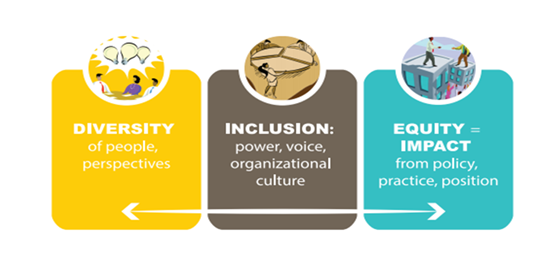By: Brittany Grimes Zaehringer
Monumental leadership changes happening all across the Greater Akron area have spawned many discussions and articles on diversity in our community. In conjunction with the release of a study commissioned by The Knight and GAR foundations on the diversity of nonprofit boards, the Akron Beacon Journal held discussions with ‘diverse’ groups and individuals to assess the ramifications of these changes in the community and reported them in their recent leadership series. While I believe that there is great value in discussing, valuing, and even achieving diversity in our community, I am concerned that a narrow view of diversity, what is our composition, is not enough to overcome some of the most seemingly intractable problems we face today-economic, educational and health disparities, in particular.
Recently, my colleague Suzanne Allen, President and CEO of Philanthropy Ohio, introduced me to Michael Shinn, who was the Chair of the Diversity Committee of Philanthropy Ohio. I was immediately struck by Mr. Shinn, who I learned was a retired engineer from GE, owned his own financial services company, and was founder and secretary of the Shinn Family Foundation in Cleveland. Mr. Shinn was instantly charming and I found myself unable to refuse his request to serve as a new member of his committee. Beyond Mr. Shinn’s charm was his philosophy on the work ahead for the committee. He felt that equity and inclusion were paramount to the work of advancing the common good. Shinn felt so strongly about expanding the narrow definition of diversity, that he was in the process of changing the name of the committee to Diversity, Equity and Inclusion (DEI) and revising the diversity principles of Philanthropy Ohio and other policies related to ‘diversity’ to ensure that everyone could be grounded in not only using the same terms, but having the same meaning and understanding.
Sadly, Mr. Shinn passed away three days after I had the pleasure of meeting him. However, the work he began at Philanthropy Ohio is anything but gone. The committee has continued under the leadership of Susan Urano from The Athens Foundation, and we are currently working on Mr. Shinn’s vision of expanding the focus of diversity in philanthropy to include equity and inclusion and to advance these principles within the membership. As terms and definitions are considered, our work is guided by D5; a five-year national coalition to advance philanthropy’s diversity, equity, and inclusion.
At a basic level, diversity deals with the composition of things; while inclusion and equity attempt to impact societal outcomes by tackling organizational and cultural structures through effectively engaging diverse voices and reforming policies that sustain discriminatory and exclusive systems. (For full definitions, please see What is DEI?)

DEI is not one size fits all. The context in which you discuss issues of diversity is very important.
For me, my professional lens on diversity is in the context of philanthropy. While working with Philanthropy Ohio and the Association of Black Foundation Executives’ Leadership Development Cohort, Becoming a Transformational Leader with an Equity Lens, I’ve come across some information that I think would be useful to a wide array of organizations seeking to embed DEI in their work.
Here are some things to keep in mind:
- Leadership on DEI must come from the top and be inclusive-Don’t leave it up to the few women and minorities in the group to carry the load
- The organization must develop an agreed upon definition of DEI related to the context of the organization and its stated mission; Refrain from using or clearly define all proxy terms, e.g. at-risk, disadvantaged
- Use data ethically; Collect data to establish benchmarks and track progress-You can’t move the needle if you don’t understand where things are now and why things are the way they are
- Establish explicit DEI outcomes and accountability for achieving them
- Understand that there are layers within demographic groups-all minorities don’t understand poverty or fatherlessness
- Engage the community/your constituents and ensure that your leadership is representative of the community. You may have to go places that are unfamiliar and maybe uncomfortable at first.
- Continually assess your results; eliminate what isn’t working and build upon what is
- There is no one right answer
- Sincerely apologize if you make a mistake; sincerely accept sincere apologies
- Be responsible for your own learning and experiences
The list is by no means prescriptive or all-encompassing. It is a start. Perhaps the sector in which you seek to have an impact has begun looking at DEI in a comprehensive way; maybe there is an alliance with a mission similar to D5 for you to seek guidance. If not, see what other sectors are doing and adapt something that can work for you.

For the broader community, embedding DEI is beyond an ethical or moral imperative; it is an economic imperative as well. We know from the research of the Fund For Our Economic Future that communities and regions fail over time when large segments of society are habitually excluded from opportunities to participate and succeed.
As we begin to expand our view on diversity, we must remember that diversity, equity and inclusion will not happen by good intentions alone.
This excerpt from an article published by Philanthropy Ohio shortly before his passing perfectly illustrates Mr. Shinn’s thoughts on the importance of moving beyond diversity:
Our major institutions are operating under the traditional premise of white, male-dominated society, while the nation’s demographics are going in a different direction. For the United States to remain the leader of the “free world” over the long-term future, our major institutions have to recognize and embrace the changing demographics of the population and implement a plan for diversity, equity and inclusion in their organizations and for those they serve.
